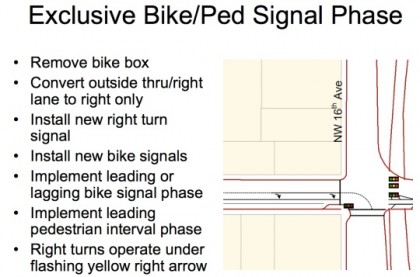
Concerned about a very high rate of right-hook collisions and general traffic “chaos” at the intersection of NW 16th and Everett (map), the bureau of transportation is drawing up plans they hope will make it safer.
“We’re seeing a comparable number of crashes, with five times less bike volume,” said Sullivan. “It’s alarming.”
— Andrew Sullivan, PBOT traffic engineer
This intersection is no stranger to the city’s traffic engineers and safety experts. In 2007, following two fatal right-hook collisions, then Transportation Commissioner Sam Adams put 16th and Everett on a list to receive a bike box. That bike box was installed a few months later; but the bike safety issues didn’t go away. In October 2010, PBOT singled out the intersection as one of four locations (out of 11) citywide where collisions actually increased after a bike box was installed.
Now this notorious intersection is once again getting attention due to its high rate of right-hooks.
City Traffic Engineer Andrew Sullivan presented more about the current conditions and possible solutions at the PBOT Bicycle Advisory Committee meeting Tuesday night (PDF of his presentation).
“There’s a lot of chaos going on here,” said Sullivan as he reviewed the street’s dimensions and collision history. According to DMV and Police statistics the intersection of 16th and Everett has the second highest number of right hook collisions among all bike box locations in Portland. PBOT evaluated the performance of bike boxes in 2012 and found that there were 7 right hook collisions at this location. Only SW 3rd and Madison (the site of Kathryn Rickson’s death via right hook in May 2012) has more collisions, recording 11 in the same period.
But what shocked PBOT was the frequency of collisions: 16th and Everett recorded just 57 bikes in a peak-hour count while there were 270 bikes counted during peak-hour on Madison. “We’re seeing a comparable number of crashes, with five times less bike volume,” said Sullivan. “It’s alarming.”
There are several reasons for all the “chaos” and collisions at 16th and Everett. One of the two lanes is an entrance to I-405. At peak hour, 268 people turn right to get onto the freeway. Auto traffic tends to back up in the right lane because there’s no turn on red and the crosswalk is also very busy. Another factor is that it’s a slight downhill so people riding bicycles go faster than usual, making it even harder for people to know if it’s safe to turn across the bike lane. As stress builds up while waiting for a gap to enter the freeway onramp, people are more prone to make unsafe decisions.
Here’s a slide from Sullivan’s presentation showing how the intersection is used (counts taken during a peak hour in September 2012):

To solve some of issues, PBOT is considering two “mitigation alternatives”: A new traffic signal with an exclusive phase for bikers and walkers; or a left-side bike lane (Everett is a one-way street).

As you can see from Sullivan’s slide above, this option would involve mostly new signals and new lane signage and striping. Since the right standard lane would become a right-turn only lane, PBOT is concerned about a reduction in auto capacity. To make up for that, they’re proposing to allow people to turn onto the freeway during a flashing yellow interval. Right turners would always see red when the bike-only green was showing, but it would be yellow at other times. The flashing yellow arrow idea raised concerns from Bike Advisory Committee members familiar with similar turn arrows more commonly found in Washington County and other suburban intersections.
Left side bike lane
In this option, PBOT would move the bike lane from the right to the left side from NW 19th to just before 14th (to avoid left hooks at 14th, they’d drop the bike lane a few hundred feet prior to intersection and add a sharrow). If you’re driving on Everett and want to turn left (north) on either 18th or 15th, you’d do so by crossing over the bike lane prior to the intersection. To create this new left-turn lane, PBOT would break the bike lane striping before the intersection and remove a few on-street parking spaces.
Each one of these options introduces other possible conflict zones and has some drawbacks; but there are also advantages. Here’s how PBOT lays out the pros and cons of each one..


In committee discussion that followed PBOT’s presentation, city bike coordinator Roger Geller and Sullivan talked about even grander plans for Everett. PBOT has analyzed traffic operations on the street and found that they could re-allocate road space and create a cycle track or buffered bike lane all the way west to 23rd without having a major negative impact on current auto traffic volumes.
For now, it appears that the left side bike lane option has the most support. Committee member Rob Sadowsky with the Bicycle Transportation Alliance shared that both of his children have been right-hooked at this location. He said the BTA would support the left side bike lane option but thinks either one would work better that the existing design. In a straw poll, a majority of committee members voted for the left side bike lane.
Beyond the engineering and design considerations, the left side bike lane also appears to be easier from a process and funding perspective. The signal changes would have to go through ODOT (since they control everything over the freeway) and signal work is relatively expensive. On the other hand, the left-side bike lane option would be relatively cheap and easy and could be pegged for completion along with an already scheduled paving project due on Everett this spring/summer.
Do you ride, drive, or walk through this intersection? What do you think?


